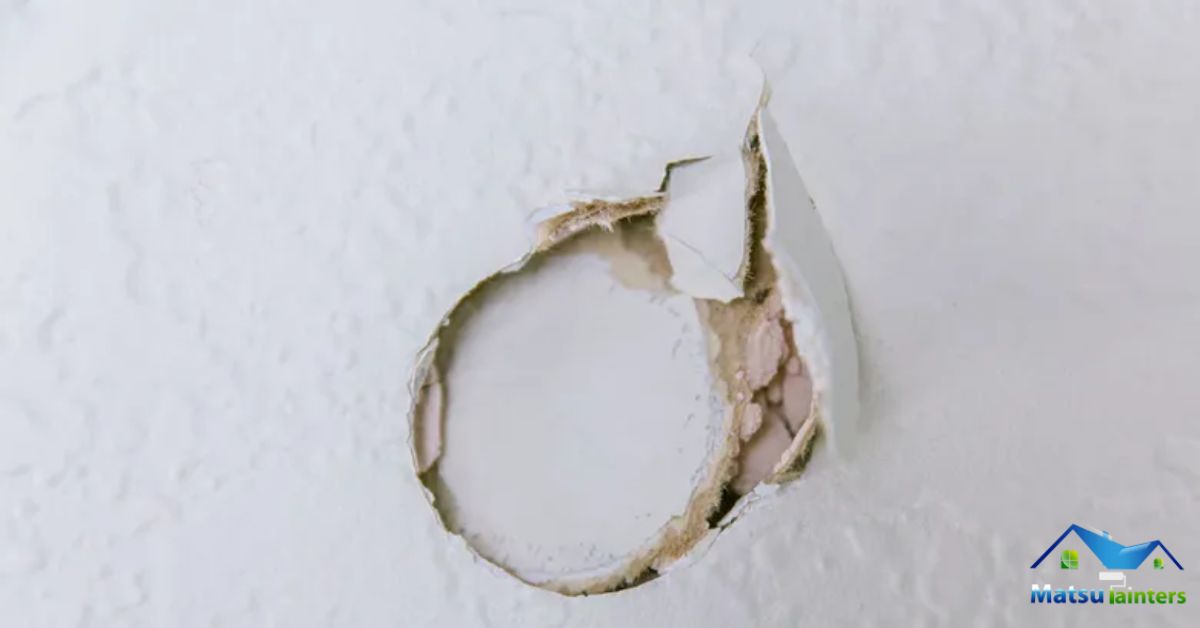It’s one of those discouraging moments when you find that big hole in your drywall. They require more effort, time, and specific materials as opposed to repairing them because large ones are incomparable to small holes or cracks. On the other hand, whether it is an accidental injury or a more serious incident, how to fix a large hole in drywall is a very important criterion for maintaining the appearance and strength of the wall. This tutorial will show you step-by-step how to do this and give pointers on how to find the best drywall installation service and drywall service near me.

Understanding Drywall Damage
Before we dive into How to Repair Large Hole in Drywall, it is important first to comprehend what drywall is and why it tends to experience a lot of damage. Drywall is also known as gypsum board or plasterboard. It is essentially a construction material, the major component of which is gypsum sandwiched between two bulk papers. It’s highly consumed because it’s lightweight and installable easily, forming a smooth, paintable surface. Still, its composition allows it to be susceptible to various damages, which are mostly by impacts, moisture, or poor installation.
Large holes in drywall are likely to happen when someone knocks the wall with lots of force. This may be a doorknob slapping up against the wall, furniture bumping into it as it is being installed, or tools dropped during the extensive renovations many people are doing to their homes. Thankfully, knowing How to Repair Large Hole in Drywall may be something that can be controlled with the right set of tools and techniques.
Tools and Materials Needed
Before the actual repair, gather this equipment and material:
- Utility knife
- Drywall saw
- Measuring tape
- Pencil
- Drywall screws
- Drill
- Drywall patch: This is the piece of wallboard that will match the thickness of your solid wall.
- Joint compound: This is what is otherwise known as drywall mud. This is like a paste applied to finalize the look of the wallboard.
- Drywall tape
- Sanding sponge, or sandpaper
- Paint and primer, if necessary
- Putty knife
Given all these materials and equipment, it would be pretty much self-explanatory on How to Repair Large Hole in Drywall.
Step 1: Evaluate the Hole
First, examine the size and shape of the hole. It will dictate the extent to which the repair work is going to be carried forward. For bigger holes, you can cut away a square or rectangular area of drywall to enhance ease and cleanliness while repairing. This step forms the most crucial part of how to repair large holes in drywall, as it shall ensure that the patch is snug and secure.
Step 2: Cut Out the Damaged Area
Cut out the damaged section using a utility knife or drywall saw. Preferably, this hole should be made squarish or rectilinear, because drywall patches would be much easier to fit onto the hole, even if the hole is shaped irregularly. It should be sure that the drywall is cut through and that there is no debris, or some other loose matter, on its borders.
Step 3: Prep the Patch
Next, measure the dimensions of the hole then size the drywall to the same dimensions. The fit should be fast and require very minimal force to fit. If you have the impression you can not cut drywall, don’t stress. You can always consult a professional from drywall installation services near you or simply search for drywall service near me.
Step 4: Patch INSTALLATION
Put the patch in place over the hole and attach it by driving in a few drywall screws. Because the patch is still firmly attached to the scrap wood, it will not be pulled through the hole. Make sure you are screwing into the studs behind the drywall. Use the drill to drive the screws and make sure not to tighten them too much, so the screw heads are just below the surface of the drywall.
Step 5: Lay down some drywall tape
Once the patch is held in place firmly, you can cover the seams between the patch and the existing drywall with drywall tape. The tape will make an easy, stress-free connection from the old to the new drywall, preventing cracks that emerge later. Proper application of drywall tape is among the ways How to Repair Large Hole in Drywall to ensure a smooth surface.
Step 6: Use Joint Compound
Spread joint compound over the seams with a putty knife and make sure it smoothly feathers out at the edges so it is blended into the wall. Apply two or three coats of joint compound over the first coat; be prepared to do some very light sanding between each coat to get a smooth surface.
After the last pass of the joint compound is completely dry, the surface is smoothed out by sanding with a sanding sponge or fine-grit sandpaper. Great care must be taken not to sand too hard or it will damage the drywall and create areas that are not flush. Once the area is smooth, wipe it with a damp cloth to clean off the dust.
Step 8: Prime and Paint
Finish the repair by priming and painting the area with the same paint as the rest of the wall. This can sometimes be deemed an optional step, but it is highly recommended if you want the repair to be undetectable. Priming and painting are critical final elements in How to Repair Large Hole in Drywall because they help to restore the wall’s appearance.
When to Call in the Professionals
Although most homeowners can easily determine How to Repair Large Hole in Drywall, there indeed are instances where their intervention would be called for. If the hole is simply too big or the drywall damage is no longer superficial, calling for experts would be a better choice. A repairman offering services in drywall installation usually has all the experience and tools required to carry out complicated repairs.
Moreover, if you do not have faith in your ability to come up with the best-suited repair then maybe you should get that drywall service near me. They will make sure that the repair is carried out in the right way and take enough of your time and potential frustrations away.
Finding the Right Drywall Service Near You
In the eventuality that you choose professional help, you must seek service from the right provider. Here are some tips that can help you in finding the best drywall service near me:
- Check Online Reviews: Look for companies with positive reviews from previous clients. You can be able to learn a lot about quality and customer service to be expected from the reviews.
- Ask for Referrals: If you know a recent person who did drywall work, you might want to ask for referrals: personal referrals might get you some pretty reliable information.
- Check the Qualifications: Ensure that the company you are hiring is duly licensed, properly insured, and comes with enough experience in carrying out drywall repair. It will ensure your interest is protected in case of any issues with the repair.
- Get Several Quotes: You can contact several companies to provide you with quotes for repair. In return, you get to know the average price as well as secure a good deal in the process.
- Project Discussion: You should talk over your project with your contractor before hiring. What this means is that the contractor should know and fathom what the project is all about and be able to give a timeline for the task.
So, choosing the right drywall service near me could genuinely influence your repair results by doing your homework and selecting a trustworthy provider.
Conclusion
A large hole in drywall can easily be repaired if recognized with appropriate tools and methods. Nevertheless, in case you want a finish without shows or the repair job is looking formidable to you, it is always better to seek the experts. For those who badly need the expert help that can save lives, Matsu Painters offers the perfect service for drywall repair and installation. With experience, their services result in top-quality work. You can contact them at Matsu Painters directly at 907-315-2291 or message at info@matsupainters.com. Getting your drywall restored has never been easier than it is right now, by yourself or by an expert.
